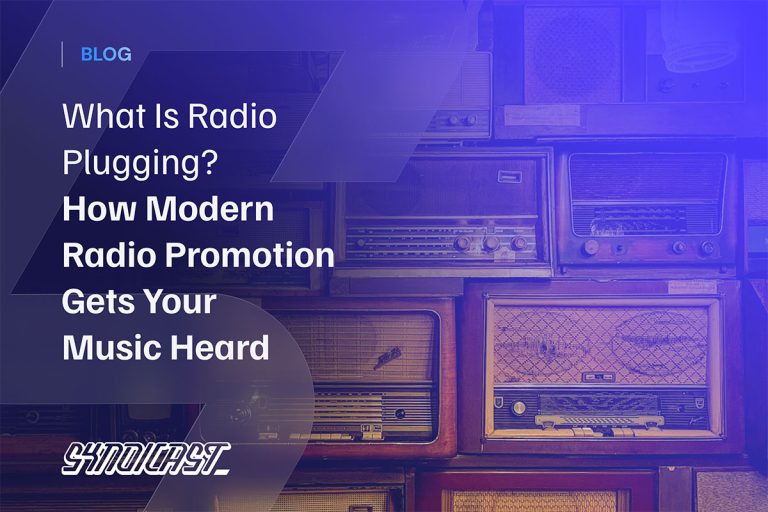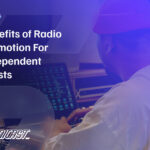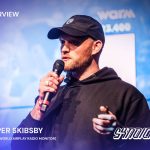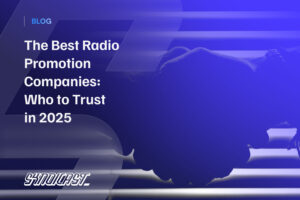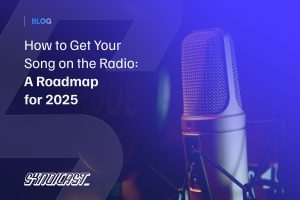In an age of endless streaming options, it might be tempting to underestimate the power of radio. Yet, with a staggering global weekly reach of over 29.2 million listeners for a single commercial radio group in the UK alone, traditional and digital radio remains a titan of music discovery and a cornerstone of any successful release strategy.
For artists and labels aiming to break through the noise, understanding the art and science of getting their music on the airwaves is more crucial than ever. This is where radio plugging comes in.
This article will unpack the intricacies of modern radio promotion, guiding you through the evolution of this vital industry practice and providing a blueprint for a successful 2025 campaign.
In This Article…
- A definition of radio promotion and radio plugging
- The anatomy of the best radio promotion campaigns in 2025
- Learn how to promote your music
- A breakdown of DIY vs. pro services
What is Radio Plugging?
At its core, radio plugging is the strategic process of getting a new song played on the radio.
A “radio plugger” or a radio promotion company acts as the crucial intermediary between an artist or record label and the key decision-makers at radio stations like radio DJ directors and radio programmers. These decision-makers can include station managers, music directors, producers, and individual DJs. The plugger’s role is to champion a track, leveraging their industry relationships and expertise to persuade stations that a song is a good fit for their audience.
The importance of radio plugging in the modern music industry cannot be overstated. While streaming platforms have democratized music distribution, they have also created a saturated market where it’s incredibly difficult to stand out. Radio, in its various forms – from traditional FM and AM to DAB (Digital Audio Broadcasting), satellite radio, and a burgeoning world of internet radio stations – offers a curated listening experience. For listeners, radio worldwide is a trusted source of music discovery, and for artists, it’s a powerful tool for reaching a broad, engaged audience.
A successful radio promo campaign can lead to a cascade of positive outcomes, including more listeners, an expanded fan base, radio interviews, music video engagement, downloads, CD and ticket sales for tour dates, as well as heightened interest from publishers, booking agents, and other music business professionals.
Inside a 2025 Plugging Campaign: Timeline, Assets & KPIs
A successful radio plugging campaign in 2025 is a meticulously planned and executed operation. It’s a multi-stage process that begins long before a song is released and continues for weeks or even months after. Here’s a breakdown of the key elements for the best music promotion campaign:
Campaign Strategy: Preparation, Launch, and Momentum
Our approach to campaign launches is strategically timed to maximize impact and ensure all systems are go for a successful release. While some promotional timelines, particularly for traditional radio, can begin months in advance, at Syndicast we have refined a model that concentrates the main campaign launch around the official release day. This methodology is designed to protect the integrity of the release and leverage crucial discovery platforms from the very first moment.
Here’s a breakdown of our campaign phases:
Phase 1: Pre-Release Asset Preparation & Strategy (4-8 weeks pre-release)
This crucial initial phase is focused on internal preparation. We do not send music to our main contacts during this time. Instead, we work closely with the artist and their team to build the foundation for the campaign.
- Strategic Planning: We define the target audience, identify the key media and radio targets, and establish clear, measurable goals for the release.
- Asset Creation and Collation: We ensure all promotional materials are perfected and ready for launch day. This includes gathering high-resolution artwork, a comprehensive press kit, and creating any necessary edits of the track (e.g., radio edit, extended mix).
Phase 2: The Launch – Release Day Campaign Activation (Release day or a few days prior)
The primary external push begins on or just before the official release date. This timing is deliberate and serves several key functions:
- Preventing Leaks: Sending music to a wide network of contacts weeks in advance significantly increases the risk of leaks, which can undermine a release’s impact. By launching closer to the date, we safeguard the track’s exclusivity.
- Ensuring Airplay Monitoring: Official airplay monitoring services primarily track commercially released music. Launching the campaign upon release ensures that every play is accurately logged, providing crucial data to build momentum.
- Enabling Shazam & Song Recognition: For a song to be identified by services like Shazam, it must be registered in their database, which typically occurs upon release. A release-day launch means that any listener who hears the track can immediately identify it, capturing potential fans who might otherwise be lost.
While our main campaign launches on release day, targeted pre-release promotion may be utilized for specific audiences like key club and radio DJs who require music earlier for mix-show preparation.
Phase 3: Post-Release Follow-up and Momentum (Ongoing from release)
Once the campaign is live, our focus shifts to persistent follow-up and building momentum.
- Systematic Follow-up: We employ a regular, professional cadence of follow-ups to keep the track on the radar of busy producers, editors, and music directors.
- Monitoring & Reporting: We diligently monitor airplay, streams, and press coverage, sharing positive results with other media outlets to encourage further support and leverage success for new opportunities.
Assets: Radio DJ Edit, One-Sheet, ISRC, Metadata
To give a song the best possible chance of success, it needs to be presented in a professional and easily accessible package. The essential assets for a 2025 radio plugging campaign include:
- The Radio Edit: This is a version of the song that has been specifically tailored for radio play. It’s typically shorter than the original album version (ideally under 3 minutes and 30 seconds), with any explicit language removed. A good radio edit will get to the chorus quickly and maintain a high level of energy throughout.
- The One-Sheet: This is a concise, one-page document that provides all the key information about the artist and the release. It should include a brief bio, high-quality press photos, links to social media and streaming platforms, and key selling points for the track.
- ISRC (International Standard Recording Code): This is a unique identifier for a specific recording. It’s essential for tracking airplay and ensuring that royalties are paid correctly.
- Comprehensive Metadata: In the digital age, metadata is king. This includes all the information embedded in the audio file, such as the artist name, song title, album title, genre, and ISRC code. Accurate and complete metadata is crucial for ensuring that a song is properly cataloged and reported by radio stations.
Music Industry Metrics: Adds, Spins, Shazam Hits, Geographic Data
The success of a radio promotion campaign is measured by a variety of key performance indicators. These metrics provide valuable insights into how a song is resonating with audiences and where it’s gaining traction. Key KPIs include:
- Adds: An “add” is when a radio station officially adds a song to its playlist. This is the primary goal of any radio plugging campaign.
- Spins: A “spin” is a single play of a song on the radio. The number of spins a song receives is a direct measure of its airplay. Whether it’s a national or international station.
- Shazam Hits: Shazam is a powerful website and tool for measuring audience engagement. When a listener uses Shazam to identify a song they hear on the radio, it’s a strong indication that the track has captured their attention.
- Geographic Data: By analyzing where a song is being played and Shazamed, pluggers can identify key markets where the artist is gaining popularity. This information can be used to inform tour routing, targeted marketing campaigns, and other strategic decisions.
Reach Radio Stations Now with Syndicast’s Radio Promotion Services
For artists and labels looking to navigate the complexities of modern radio promotion, partnering with a professional service can be a game-changer. Syndicast offers a comprehensive and data-driven approach to radio plugging, designed to get your music heard by the right people at the right time.
- Global Reach: With a network of over 2,400 radio stations in more than 120 countries, Syndicast can connect your music with a truly global audience.
- Targeted Promotion: Our team of experts will work with you to develop a bespoke promotion strategy, targeting the specific radio formats and stations that are the best fit for your music.
- Real-Time Analytics: Our innovative platform provides you with real-time access to detailed campaign data, including airplay reports, Shazam hits, and geographic insights.
Ready to take your music to the next level? Visit our Radio Promotion service page to learn more and submit your track today.
Syndicast Campaign Success Story: Real Results for Artists
Here’s a glimpse of what Syndicast can achieve, based on real campaign data:
- Global Reach, Validated Airplay: For one campaign featuring a well-known artist on a major label, our platform facilitated the track being downloaded by an impressive 361 unique radio stations across 54 countries. This translated into approximately 56,644 verified radio plays, showcasing the extensive international reach and validated airplay we can deliver.
- Impact for Emerging Artists: It’s not just established names that benefit. In another case, Syndicast’s efforts were instrumental for a lesser-known artist, contributing to 42% of all radio stations playing their track. This demonstrates our ability to significantly elevate the profiles of emerging talent.
- Comprehensive Promotional Tools: Our success is driven by a robust platform that includes effective promotional tools, Artist ID integration, and customizable power intro production. Crucially, all airplay is validated using industry-standard third-party monitoring data, ensuring transparency and accurate reporting.
These examples illustrate how Syndicast’s strategic approach to radio plugging empowers artists and labels to achieve tangible success in the competitive music landscape. We provide the connections and tools necessary to get your music heard by the right people, in the right places.
DIY vs. Pro Pluggers: Decision Checklist
Deciding whether to take a do-it-yourself approach to radio promotion or to invest in a professional plugger is a key decision for any artist. Here’s a checklist to help you weigh the options:
| Factor | DIY Approach | Professional Plugger |
| Cost | Lower upfront money requirement, but can be time-intensive with no guarantee of results. | Higher upfront investment, but can deliver a significant ROI through strategic, targeted promotion. |
| Time | Extremely time-consuming, requiring hours of research, outreach, and follow-up. | Frees up your time to focus on creating music, while experienced professionals handle the promotion. |
| Relationships | You’ll need to build relationships with radio stations from scratch, which can be a long and difficult process. | Professional pluggers have established relationships with key decision-makers, giving your music a direct line to the people who matter, reaching new heights. |
| Expertise | Requires a steep learning curve to understand the nuances of the radio industry and what makes a successful pitch. | You benefit from the knowledge and experience of industry veterans who know what it takes to get a song on the air. |
Ready for Spins? Your Next Step for Radio Airplay
In the crowded and competitive landscape of the modern music industry, radio promotion remains one of the most effective ways to cut through the noise and connect with a large and engaged audience. A professional radio plugging campaign can be the catalyst that takes your career to the next level, opening doors to new opportunities and a wider fanbase. By understanding the process, preparing your assets, and partnering with the right team, you can harness the enduring power of radio to get your music heard.
If you’re ready to invest in a professional radio promotion campaign that delivers real, measurable results, your next step is to get in touch with the team at Syndicast. Visit our service page to learn more and start your journey to global airplay.
FAQs About Radio Promotion
How much does a radio promotion cost?
The cost of a radio promotion campaign can vary widely depending on the scope and duration of the campaign, the target territories, and the level of service required. A small, targeted campaign for a new artist might cost a few hundred pounds, while a major international campaign for an established artist could run into the thousands. It’s important to view radio promotion as an investment in your career, and to choose a service that offers a clear and transparent pricing structure.
What type of promotion is radio?
Radio is a form of broadcast media promotion. It falls under the broader umbrella of public relations and marketing. Unlike advertising, where you pay for a specific number of ad spots, radio promotion is about earning airplay based on the merit of the music and the strength of the pitch.
What are the disadvantages of radio promotion?
While radio promotion offers a wealth of benefits, there are a few potential disadvantages to consider. The main challenge is that there is no guarantee of success. A plugger can get your music in front of the right people, but they can’t force them to play it. It can also be a significant financial investment, particularly for independent artists. Finally, with the fragmentation of the radio landscape, it can be difficult to achieve the same level of mass-market reach that was possible in the past. However, for most artists, the potential rewards of a successful radio campaign far outweigh the risks.

